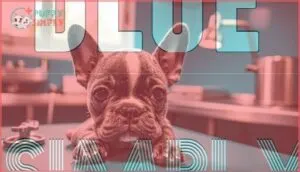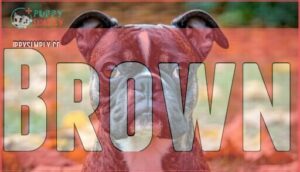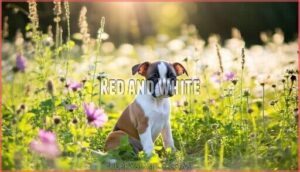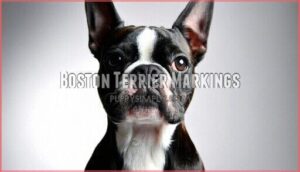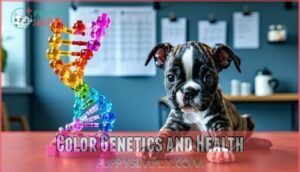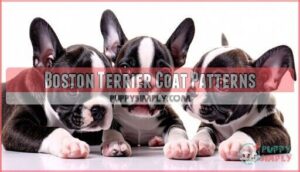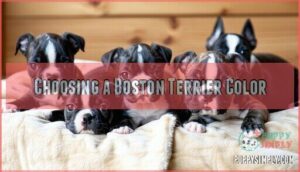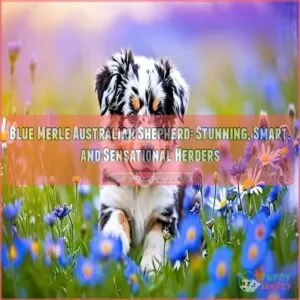This site is supported by our readers. We may earn a commission, at no cost to you, if you purchase through links.
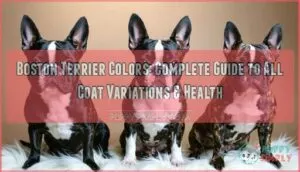
The American Kennel Club (AKC) recognizes specific combinations, such as black, brindle, or seal with white markings, while rarer hues like fawn or red can still steal hearts.
Their coat patterns and markings, like the charming Haggerty spot (a dot on the head), add personality.
However, some colors, especially diluted ones, may be linked to health concerns like color dilution alopecia. Always prioritize health and temperament over rarity when choosing your Boston’s coat—style meets substance here!
Table Of Contents
- Key Takeaways
- Boston Terrier Colors Explained
- AKC Recognized Colors
- Rare Boston Terrier Colors
- Boston Terrier Markings
- Color Genetics and Health
- Boston Terrier Coat Patterns
- Health Problems and Colors
- Choosing a Boston Terrier Color
- Frequently Asked Questions (FAQs)
- Which is better Boston Terrier or French Bulldog?
- How many colors to Boston Terriers come in?
- Why are Boston Terriers black and white?
- What color Boston Terriers does AKC recognize?
- What is a seal-colored Boston Terrier?
- What 2 breeds make a Boston Terrier?
- What color is a splash Boston Terrier?
- What is the average lifespan of a Boston Terrier?
- Are Boston Terriers easy to train?
- Are Boston Terriers good with children?
- Conclusion
Key Takeaways
- You’ll find Boston Terriers come in five AKC-recognized colors (black, brindle, and seal with white markings), but rare colors like blue and lilac carry serious health risks including color dilution alopecia that causes hair loss and skin problems.
- You should prioritize health and temperament over flashy coat colors when choosing your Boston Terrier, as personality traits remain consistent across all color variations while rare colors often indicate questionable breeding practices.
- You can identify purebred Boston Terriers by their required white markings on the muzzle, between the eyes, and chest that create the signature "tuxedo" appearance, with additional desired markings enhancing their formal look.
- You need to understand that coat color directly connects to genetics and health—while standard colors are generally safe, diluted colors like blue often lead to chronic skin conditions and other complications that’ll require lifelong management.
Boston Terrier Colors Explained
You’ll find that Boston Terriers come in five officially recognized color combinations, each featuring the breed’s signature white markings that create their famous "tuxedo" appearance.
Understanding these color variations helps you recognize authentic Boston Terrier genetics and appreciate how specific pigments like eumelanin and pheomelanin work together to produce each coat pattern.
Black & White
With their classic tuxedo markings, black and white Boston Terriers represent the most common color combination you’ll encounter.
This striking contrast creates the breed’s signature "American Gentleman" appearance that meets show dog standards perfectly.
The tuxedo markings transform every Boston Terrier into a distinguished gentleman ready for any formal occasion.
The genetic dominance of black pigmentation makes these Boston Terrier colors highly prevalent, while their distinctive Boston Terrier markings showcase the breed’s formal elegance beautifully.
Stress from new environments can even cause a black Boston Terrier to develop premature graying.
Brindle & White
Your brindle Boston terrier showcases stunning pattern variations with tiger-like stripes throughout darker coat areas.
Brindle genetics create this distinctive look where:
- Light and dark hairs intermingle like paintbrush strokes
- Stripes appear most prominently on back and sides
- White markings frame the face in perfect contrast
- Each dog’s brindle pattern remains completely unique
This breed standard combination balances rarity factors with classic Boston terrier colors and markings.
Black Brindle & White
You’ll notice Black Brindle & White Boston Terriers showcase striking brindle stripe intensity across their black base coat.
These boston terrier colors feature distinct black distribution patterns with tiger-like stripes creating visual depth.
White marking variations follow standard boston terrier markings requirements.
Genetic dominance determines brindle boston terrier patterns, making each dog unique.
Show ring standards favor balanced stripe distribution in this boston terrier breed variation.
Seal & White
When you’re trying to spot a seal boston terrier, you’ll need patience for proper seal identification.
This coat appears solid black until light exposure reveals those telltale red undertones that meet AKC standards.
The genetic markers create this unique coloring, while traditional white markings on the chest, muzzle, and between the eyes complete the classic boston terrier colors combination that defines this distinctive variation.
Seal Brindle & White
You’ll find Seal Brindle & White boston terrier colors combine the mysterious seal base with distinctive brindle stripes throughout darker areas.
This boston terrier markings pattern creates incredible uniqueness compared to standard seal and white combinations.
The brindle boston terrier genetics produce tiger-like striping that’s only visible in proper lighting.
Color rarity makes these dogs special, though they meet breed standard requirements perfectly.
AKC Recognized Colors
The American Kennel Club AKC recognizes five standard colors for boston terrier colors that meet strict breed standards.
These include Black & White, Brindle & White, Black Brindle & White, Seal & White, and Seal Brindle & White.
Each color must feature specific white markings on the muzzle, between the eyes, and chest to qualify for breed recognition.
Show standards require these boston terrier markings to create the signature "tuxedo" appearance.
Color criteria guarantee consistency across the breed while maintaining the distinctive boston terrier standard that judges expect in competition rings, ensuring a strict breed standard and competition rings.
Rare Boston Terrier Colors
While AKC-recognized colors are common, you’ll find several rare Boston Terrier colors that aren’t accepted in competitions but still make wonderful pets.
These unique variations include blue, lilac, brown, red and white, and fawn coats that result from specific genetic combinations, though they may come with increased health risks you should understand before choosing a rare Boston Terrier.
Lilac
Lilac Boston Terriers showcase a breathtaking silvery-gray coat that’ll make you do a double-take.
This rare boston terrier color results from complex boston terrier genetics involving the dilute gene, creating stunning lilac appearance variations.
This unique color is often sought after by those who appreciate rare coat colors.
Here’s what makes lilac so special:
- Lilac Genetics – Both parents must carry recessive dilution genes
- Lilac Rarity – Less than 5% of all Boston Terriers display this coloration
- Lilac Health – Potential color dilution alopecia risks require monitoring
- Lilac Breeders – Specialized breeding programs command premium prices
Blue
Blue Boston Terriers carry a dilution gene that transforms black pigmentation into steel-gray coloring.
While blue and white combinations attract many owners, blue genetics create serious breeding concerns.
CDA prevalence runs high in blue-coated dogs, causing progressive hair loss and skin problems.
Though color popularity continues growing, responsible breeders avoid producing blue Boston Terrier puppies due to significant health implications.
Extensive white markings can also increase the risk of hearing and deafness.
Brown
Brown Boston terrier colors aren’t AKC-recognized but include liver variations and chocolate genetics creating stunning coat appearances.
These brown dilutions result from specific eumelanin mutations, producing chocolate, liver, fawn, and tan points throughout the coat.
While beautiful, brown-tinted coats may indicate genetic diversity concerns. You’ll find these rare colorations often confused with seal coats in certain lighting conditions.
Red and White
Red and white Boston Terriers showcase stunning brownish-red tones that catch sunlight beautifully.
These rare coat colors aren’t recognized by breed standard but make wonderful family pets.
Here are five key facts about red genetics in Boston Terriers:
- Pheomelanin pigment creates the reddish coloration
- Markings influence overall appearance substantially
- Health implications remain minimal compared to dilute colors
- Breeding programs rarely focus on red variations
- Color intensity varies from light copper to deep mahogany
Fawn
Picture a Boston Terrier sporting a coat that ranges from champagne bubbles to rich caramel – that’s your fawn boston terrier.
These fawn and white beauties showcase stunning fawn variations, from light cream to deeper red tones with black hair tips.
Fawn genetics create this rare coloring through pheomelanin pigments.
While fawn rarity makes them special, fawn health remains stable compared to other diluted dog coat colors.
Boston Terrier Markings
When you examine a Boston Terrier’s coat, you’ll notice that specific white markings create their signature "tuxedo" appearance and determine whether they meet breed standards.
You need to understand these marking patterns because they’re essential for show competition and help identify purebred Boston Terriers from mixed breeds, which is crucial for recognizing the breed standards.
Required Markings
When judging Boston Terriers in competition, specific white markings aren’t optional—they’re absolutely essential.
Without these required markings, your dog faces automatic disqualification from the show ring, regardless of how perfect everything else appears.
The breed standards demand these non-negotiable white markings:
- Muzzle Band – Clean white stripe wrapping around the muzzle area
- Blaze Placement – White marking positioned directly between the eyes
- Chest Marking – Prominent white patch covering the forechest region
- Tuxedo – Combined markings creating the signature "American Gentleman" appearance
Desired Markings
Beyond the required markings, judges look for additional white placement that creates the perfect "tuxedo" look.
You’ll want to see a white collar around the neck, white on the front legs, and white markings on the rear feet toes.
These desired markings enhance the Boston Terrier’s gentleman appearance and improve show ring scoring.
| Marking Location | Ideal Appearance | Show Ring Impact |
|---|---|---|
| White Collar | Complete band around neck | Enhances tuxedo effect |
| Front Legs | White on forelegs | Improves symmetry |
| Rear Feet | White on toes only | Completes formal look |
| Overall Symmetry | Balanced white placement | Higher judge scores |
| Markings Importance | Defines breed standards | Competition success |
Haggerty Spot
You’ll occasionally spot the Haggerty spot—a rare round white marking on your Boston’s head.
This distinctive breed characteristic appears between the ears or on top of the skull, varying in spot size from small to large.
While spot genetics remain mysterious, spot prevalence stays low among boston terrier colors.
The breed standard doesn’t require this marking, making it a unique bonus feature that adds character to your dog’s white markings and overall boston terrier pattern.
Color Genetics and Health
Your Boston Terrier’s coat color isn’t just about looks—it’s directly connected to their genetic makeup and potential health risks.
Understanding the science behind coat genetics helps you make informed decisions about breeding, health monitoring, and choosing the right pup for your family, which is connected to their health risks.
Eumelanin and Pheomelanin
Your Boston terrier’s coat color comes down to two main pigments working behind the scenes: Eumelanin creates black and chocolate shades, while pheomelanin produces red and cream tones.
These pigments follow genetic control patterns that determine whether your pup sports classic black, rich chocolate, or vibrant red boston terrier colors.
This pigment production directly affects color expression and influences breed standards and potential health impacts.
You can find products affecting color for dogs online, which can be related to genetic control.
Color Dilution Alopecia
Dogs with diluted coat colors like blue and fawn boston terrier colors face a genetic challenge. Color dilution alopecia affects hair follicles, causing patchy hair loss and flaky skin.
Diluted coats come with a price—patchy hair loss and irritated skin that requires lifelong management.
This hereditary condition stems from dilution genetics mutations that weaken the hair shaft structure. Many owners seek specialized care products to help manage the condition.
- CDA Symptoms: Watch for thinning hair on your dog’s torso and scaly skin patches
- Breed Predisposition: Blue Boston Terriers show higher susceptibility than standard colors
- Coat Care: Regular moisturizing helps manage dry, irritated skin from genetic abnormalities
Deafness and Blindness
Genetic Links between certain Boston Terrier colors and sensory impairments create serious health concerns you can’t ignore.
White-heavy coats, blue eyes, and merle patterns often signal genetic abnormalities leading to deafness or blindness.
Responsible Breeding Practices avoid these risky combinations.
Early Detection through veterinary screening helps, while Assistive Devices and modified environments maintain your dog’s Quality of Life despite these challenging health conditions.
Some breeds, like Great Danes, also face similar issues, particularly with merle coat patterns, which can lead to severe health problems if not addressed through Responsible Breeding Practices.
Boston Terrier Coat Patterns
You’ll notice that Boston Terrier coat patterns fall into three main categories: solid colors, distinctive brindle stripes, and unique seal coats that change appearance in different lighting.
Understanding these patterns helps you identify your dog’s exact coloring and appreciate the genetic factors that create each Boston’s individual look, which can be influenced by the genetic factors.
Solid Colors
While color genetics shape most Boston Terrier colors, solid-colored dogs present unique breeding challenges.
You’ll rarely find a true solid black boston terrier or white boston terrier without any markings. These solid color rarity cases often indicate undesirable traits or mixed breeding.
Fawn boston terrier and red boston terrier varieties also lack the distinctive white markings that define the breed standard, creating health implications for responsible breeders.
Owners can find Black Boston Terrier products online, which may be useful for those interested in Boston Terrier care.
Brindle Patterns
Tiger stripes make brindle Boston terriers absolutely striking.
Brindle genetics create varying intensities from light to dark striping throughout the coat.
You’ll notice brindle distribution differs between dogs – some show heavy striping while others display subtle patterns.
Here’s what makes brindle variations special:
- Light brindle features faint stripes against darker backgrounds
- Heavy brindle shows pronounced dark striping patterns
- Reverse brindle displays light stripes on dark coats
- Brindle intensity varies based on genetic combinations
- Brindle rarity makes these coat patterns highly sought-after
Seal Coats
From across the yard, you’ll think your seal Boston terrier has a classic black coat until sunlight hits just right.
Seal identification becomes tricky because these coats appear jet black indoors but reveal stunning red undertones through light reflection.
Genetics can also play a role in coat color changes, as stress may trigger graying is not a key phrase to be bolded, however, genetic basis creates one of the most elegant boston terrier colors, meeting breed standard requirements while showcasing nature’s subtle artistry in coat colors.
Health Problems and Colors
You’ll find that certain Boston Terrier coat colors come with specific health risks that you should understand before choosing your pup.
While rare colors like blue, merle, and platinum might look stunning, they’re often linked to serious conditions including skin problems, deafness, and vision issues that can affect your dog’s quality of life, particularly due to serious conditions.
Platinum Health Issues
Platinum Boston Terriers’ stunning appearance comes with serious health trade-offs you need to understand.
Their genetic predisposition creates multiple challenges that affect daily life and long-term wellbeing.
These beautiful dogs face three major health concerns:
- Skin irritation and chronic allergy concerns requiring constant management
- Albinism risks that compromise immune system function substantially
- Sunscreen necessity due to extreme sun sensitivity and burn potential
Boston Terrier colors and health are closely linked, especially with rare variations. Dog colors and health research shows platinum coats carry higher rates of health conditions affecting coat colors, making preventive care essential for your dog’s comfort.
Merle Health Concerns
Merle genetics in Boston Terriers create serious health conditions you shouldn’t ignore. This controversial coat pattern often results from crossbreeding with other breeds, making true merle Boston Terriers extremely rare.
Double merles face the highest risk of severe health issues, including hearing impairment and vision defects that can range from partial to complete blindness and deafness. The merle gene’s dominant inheritance pattern means breeding ethics become essential when considering these dog health risks.
Responsible breeders avoid producing double merles entirely, as the genetic complications can devastate a puppy’s quality of life permanently. These dogs can exhibit a unique mottled coat, which is a key identifier, highlighting the importance of understanding merle genetics in Boston Terriers.
Choosing a Boston Terrier Color
When you’re choosing a Boston Terrier color, prioritize your dog’s health and temperament over coat appearance, since personality traits remain consistent across all color variations.
Remember that rare colors like blue or merle often come from questionable breeding practices and can lead to serious health problems, so stick with AKC-recognized colors from reputable breeders who focus on producing healthy, well-tempered dogs, which is crucial for their overall well-being.
Prioritizing Health and Temperament
When choosing your Boston Terrier, health over color should guide your decision.
A dog’s temperament matters more than trendy coat variations.
Responsible breeders prioritize genetic screening and ethical considerations over producing rare colors.
Your Boston’s personality, energy level, and compatibility with your family will bring years of joy.
Don’t let flashy coat colors overshadow what truly makes this dog breed special.
Rare Colors and Breeding
Rare colors like blue boston terrier varieties often result from genetic mutations that create nonstandard colors through specialized breeding practices.
While these unusual Boston Terrier colors gain color popularity among pet owners, ethical breeding requires understanding health implications.
Breeder responsibility includes educating buyers about potential risks associated with dilute genes. These fashionable coat variations may compromise your dog’s long-term health despite their striking appearance.
Responsible Breeding Practices
Good breeders prioritize health over Boston Terrier colors when selecting breeding pairs.
They conduct genetic screening for hereditary conditions and maintain breeder transparency about lineage.
Reputable breeders provide health guarantees, focus on puppy socialization, and consider ethical considerations rather than chasing trendy rare colors.
You’ll find these breeding practices produce healthier dogs with better temperaments regardless of coat genetics, which is a result of prioritizing breeder transparency.
Frequently Asked Questions (FAQs)
Which is better Boston Terrier or French Bulldog?
Boston Terriers bounce with playful energy while French Bulldogs prefer lounging—it’s like comparing a comedian to a couch potato.
You’ll love either breed, but consider your lifestyle: active adventures or Netflix marathons?
How many colors to Boston Terriers come in?
You’ll find these adorable pups come in five AKC-recognized colors: black and white, brindle and white, seal and white, plus their brindle combinations.
Non-standard colors like blue, lilac, and merle exist too.
Why are Boston Terriers black and white?
Like tiny tuxedos walking on four legs, your Boston Terrier’s black and white coat comes from specific genes controlling eumelanin pigment production.
This creates their signature "American Gentleman" appearance that’s been bred selectively for generations.
What color Boston Terriers does AKC recognize?
You’ll find the AKC recognizes three official Boston Terrier colors: black, brindle, and seal—all with required white markings on the muzzle, between the eyes, and across the chest.
What is a seal-colored Boston Terrier?
Seal-colored Boston Terriers appear solid black at first glance, but you’ll notice reddish undertones when they’re in bright sunlight or certain lighting conditions.
This AKC-recognized color creates a distinctive, rich appearance that’s quite striking.
What 2 breeds make a Boston Terrier?
Picture a genetic recipe from 1870’s England meeting American innovation.
You’ll discover your Boston Terrier descends from English Bulldogs crossed with White English Terriers.
This combination created the "American Gentleman" you adore today, which is a result of this unique genetic mix, making the Boston Terrier a beloved breed.
What color is a splash Boston Terrier?
A splash Boston Terrier displays excessive white markings beyond the breed standard, covering most of their body.
You’ll notice they’re mostly white with small patches of black, brindle, or seal colors scattered throughout their coat, which can help identify them as a splash Boston Terrier due to the distinctive markings.
What is the average lifespan of a Boston Terrier?
You can expect your Boston Terrier to live 11-15 years on average.
They’re generally healthy dogs, but you’ll want to watch for breathing issues and eye problems that can affect their quality of life.
Are Boston Terriers easy to train?
Training success rates for Boston Terriers hover around 75-80%.
You’ll find they’re moderately easy to train thanks to their intelligence and willingness to please, though their stubborn streak means you’ll need patience and consistency.
Are Boston Terriers good with children?
Boston Terriers make excellent family dogs with children.
They’re gentle, patient, and naturally protective without being aggressive.
Their playful nature matches kids’ energy perfectly, and they’re sturdy enough for active play.
Conclusion
When choosing between Boston terrier colors, remember that beauty runs more than coat-deep.
You’ve learned that AKC-recognized combinations like black and white or brindle offer the safest health prospects, while rare shades like blue or lilac carry potential risks including color dilution alopecia.
Don’t let flashy hues blind you to what truly matters—temperament and health should guide your decision.
Whether you’re drawn to classic tuxedo markings or seal variations, prioritize responsible breeders who health-test their dogs first.


